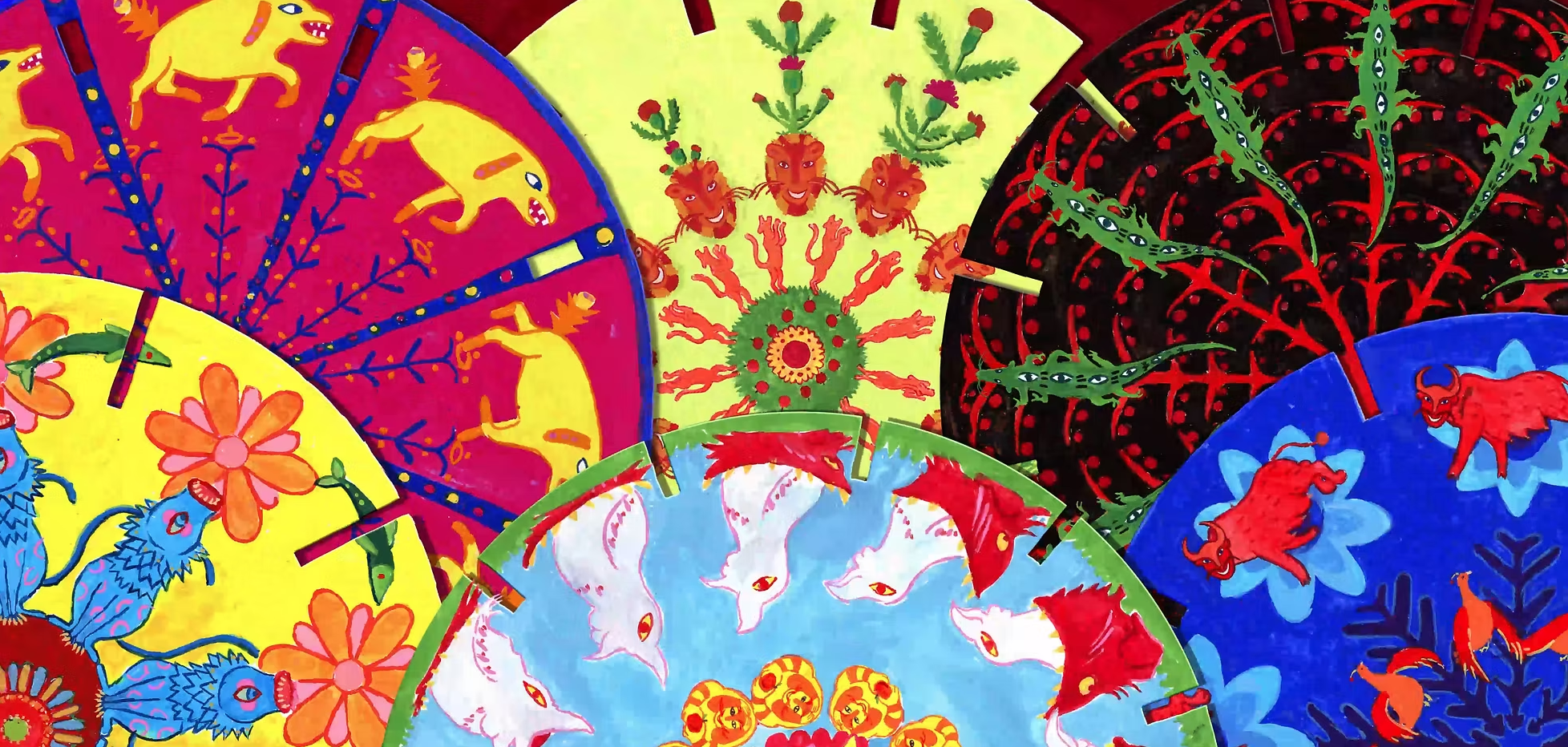Sofiya Iurkevych’s Hand-Painted Worlds Illuminate GIRAF21
Sofiya Iurkevych’s phenakistoscope disks. Photo courtesy of GIRAF.
GIRAF (the Giant Incandescent Resonating Animation Festival) is a celebration of the craft of independent animation, known for both showcasing films from around the world, and fostering Calgary’s local talent. For its 21st edition, running at the Globe Cinema this November, signal film artist Sofiya Iurkevych played a major role in shaping the aesthetic of this year’s festival.
For the festival’s official signal film, the short animated introduction that plays before each screening, Iurkevych set out to do something completely different from her usual style. While she is primarily influenced by Ukrainian folklore, and is known for work that is “a little moody, a little dark, very often dark blue,” she wanted this project to break from her usual palette, and into bright and exuberant colours, inspired by her favourite artist Maria Prymachenko.
Prymachenko’s influence can be felt in the signal film’s bold colour palette and surreal creatures. “[Prymachenko’s work] is just such incredible bold colours and shapes,” Iurkevych says. “There’s no limits, no barriers in her head on how to imagine a creature. And there’s also always something dark under all of them… that really resonates with me.”
To create the film, Iurkevych created multiple phenakistoscope disks by using gouache on watercolour paper. “That was the most fun part of it,” she says. “Usually one of [the disks] took a day, maybe less… the one with the red plant and the green lizard took two days, but it felt like years of my life,” she laughs. Each hand-painted disk, roughly 30 centimetres across, is a work of art on its own, before it’s transformed into a moving image.
If you’re interested in learning more about the phenakistoscope process, attend GIRAF’s Phenakistoscope In Full Colour workshop, where Iurkevych will go into more detail on the early 19th-century invention, and guide participants in designing their own animated loop in Adobe Photoshop. Participants will go through the process of arranging a phenakistoscope layout, as well as printing and painting the frames by hand. The result will be a mesmerizing, analog and digital hybrid that is both a physical piece of artwork and a looping digital GIF.
Alongside the signal film, Iurkevych’s short Solace will screens in GIRAF’s Northern New Wave showcase, a strikingly different work in both tone and theme. “I started [Solace] straight out of school… I would go to Fish Creek Park a lot and like probably most recently graduated people, I couldn’t properly find this solace in nature entirely. Obviously, I love Fish Creek. It's beautiful. But at the back of my mind, there's always this thought that ‘ah there's floods, there's forest fires, it's only getting worse. There's less snow every every winter, there's longer summers.’ I look at all these beautiful birds there, I know they’re eating plastic,” she says.
Her environmental anxiety became the emotional foundation for Solace. “It really upsets me and I couldn't do anything with myself but to put it in this film… When I pitched the film, it wasn't meant to be this dark. But I had to let it out somewhere.”
Another multi-media work, Solace also uses a combination of both physical painting alongside the digital animation processes. “People think [painting] takes longer,” Iurkevych says, “but I found that it actually takes me less time to get something compelling in gouache because you instantly get that texture and that unexpected bleeding of paint that is very compelling.”
As the creator behind GIRAF21’s signal film and poster, the director of the short film Solace, and the instructor of the upcoming Phenakistoscope workshop, Iurkevych’s work for the festival encapsulates GIRAF’s experimental and expansive spirit.
Iurkevych’s is also excited to take part in GIRAF’s programming this year, as she highlights their series Potatoes and Kings: Folk, Political and Absurd in Ukrainian Animation, a selection of classic Ukrainian stop-motion animation from the 1960s-1990s celebrating the surreal and subversive traditions of Ukraine’s animation history. “I’m already advising people, if you want to do stop-motion, you should just go see this pack,” she says. “It’s so different from the stop-motion that we’re used to seeing now. I just find that fascinating.”


